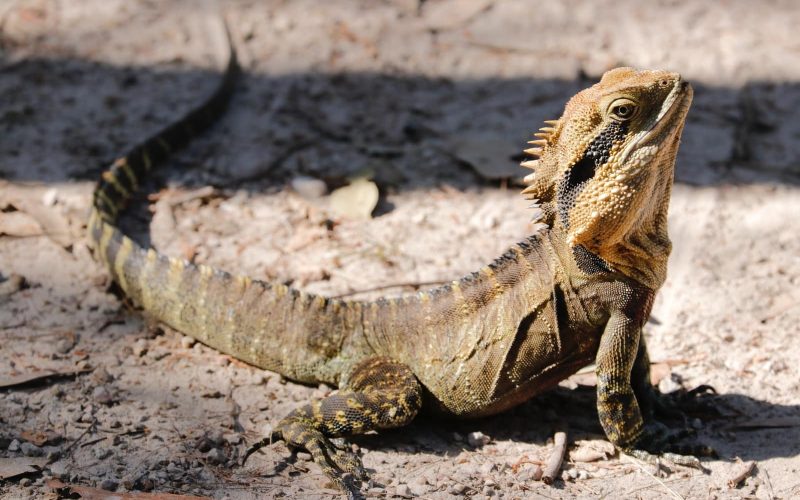The tropics of the Americas and the Caribbean are home to different types of iguanas.
They might be as little as a few millimeters in length or as large as six feet in length, but all are clever and beautiful.
Some iguanas live on land, and some reside in rocks and trees.
Dewlaps are present, and elongated scales that stretch from the center of their necks to the tails of these lizards.
Iguanas use their tails for both balance and self-defense as they climb.
When an iguana feels threatened, it may spin its tail to confuse and frighten a predator or other threat.
This is an intriguing fact about iguanas: Their muscles virtually paralyze, and they go into hibernation when the temperature dips below 40 degrees Fahrenheit.
Here are the different types of iguanas to keep as pets, some critically endangered.
1. Desert Iguana
Unlike other iguana species, the desert iguana does not climb trees or mix with dense tropical vegetation.
This particular type can only be found in dry environments throughout North America.
They live in arid regions where the heat is relentless. Iguanas in the desert have a particular appearance.
Their physical look reflects that they are not native to the lush rainforests that other lizards are.
Rather than bright green skin, these reptiles are covered in tan, brown, and gray.
Rusty brown and black are also common accent colors. The broken band pattern on the backs of most lizards serves as effective camouflage.
Another important difference is the lack of clearly defined spikes on this particular iguana.
The heads of certain lizards contain a few little spikes, but the rest of their bodies are almost completely smooth.
It’s as if these lizards don’t even have a dewlap on their chin.
Robust legs support the body of these iguanas and allow them to move through their arid surroundings.
Desert iguanas can climb plants and rocks. However, unlike other types of iguanas, these reptiles cannot scale huge trees.
They prefer to keep low and locate a safe hiding place in case of a threat.
It’s difficult to find desert iguanas for sale in the pet trade. Most animals have a hard time adjusting to life in a zoo.
However, if they grow used to the idea of living as pets, they will reward animals for caring for them.
2. Marine Iguana
It is known as Amblyrhynchus and is native to the Galapagos Islands. It has a scientific name.
An Iguana that lives on its rocky coasts and is the only one that relies only on algae to sustain itself is found here. During low tide, the females and hatchlings feed on exposed algae.
The male marine iguana can grow to 1.3 meters long and weigh 15 kg, whereas the females are only 0.6 meters long.
They spend most of their time on the rocks, where they may slow or stop their heart to prevent them from losing heat.
To avoid salt build-up, their nasal saliferous gland secretes it in crystal form and concentrates it for ejection.
3. Fiji Banded Iguana
Unlike their more common cousins, Fiji-banded iguanas have a more vivid appearance. Bright green covers the majority of the body.
The body is covered in strong vertical white, blue, or yellow stripes. The show begins with the lizard’s coloring.
Compared to other species, they have fewer prominent spikes, giving them a softer, more inviting look and feel.
Fiji banded iguanas are, as their name suggests, indigenous to the islands of Fiji.
These reptiles are so revered in the archipelago that they feature stamps and money. Due to their endangered status, Fiji banded iguanas are typically accessible to hobbyists.
The population of these animals is rapidly declining due to the devastation caused by wildfires and storms.
There is a tight prohibition on importing wild animals, yet some herpetology enthusiasts breed them in captivity. This type of iguana is smaller than green iguanas.
They stand 24 inches tall and weigh less than a pound when fully grown.
These nocturnal lizards spend most of their waking hours basking in the sun and guarding their area. They’re laid-back and unobtrusive.
This type of iguana spends the night in the shelter of the trees. When kept in captivity, Fiji banded iguanas need large cages with enough vertical climbing area.
Although primarily herbivores, juvenile lizards occasionally eat bugs or other high-protein foods.
4. Bahamian Rock Iguana
The Bahamian Rock Iguana is one of the world’s most endangered types of iguana.
The Bahamas are home to various brownish-pink iguanas with a distinctive thick-ringed tail that may reach a maximum length of three feet.
This iguana is significant to the people of the Bahamas because of its tourism relationship and the country’s largest economy.
Visitors to the Bahamas come to view the islands’ natural beauty and the Rock Iguanas in their native environment.
Iguanas from the Bahamas are herbivores, meaning they eat flowers, berries, and other fruits and vegetables.
Their tails are straight, and their legs are muscular, allowing them to scale trees and rock formations easily.
Despite their intimidating appearance, these iguanas are capable saltwater swimmers.
5. Bulabula
One of the most striking features of this type of iguana is its green color, which comes in various shades.
Researchers from Australia and the United States found this lizard species in the Fijian rainforests in 2008.
Brachylophus bulabula is the formal name given to it by scientists. As previously said, it is native to the Fiji islands and prefers to live in more humid areas.
In addition to “Hibiscus” flowers and fruits like banana, mango, and papaya, it is a herbivorous animal with spiky ridges on its back.
6. Green Iguana
Green Iguanas may grow up to seven feet long, making them the most common species. It is common for people to keep these iguanas as pets.
There are several things to consider when purchasing a Green Iguana, including a spacious cage, high temperatures, and enough humidity.
Since they are strictly herbivores, Green Iguanas don’t consume any meat or dairy products.
The Green Iguana is native to Paraguay and Brazil, although it may be found in northern Mexico.
Wild Green Iguanas may be found across the United States and even in Mexico’s Rio Grande Valley and the U.S. Virgin Islands.
In addition to their greenish coloration, Green Iguanas can have patches and stripes of several other colors, such as blue and white.
This iguana species is further recognized by its long tail, big dewlap beneath the chin, and massive, protruding teeth.
7. The Conolophus Pallidus
This iguana can only be found in Santa Fe. Its pale yellow color, large snout, and prominent dorsal spines make it unique.
To keep warm, they generally reach a height of three meters and dwell in caves.
They are omnivores, although they mostly eat tiny plants, certain shrubs, and cacti, which provide them with the moisture and water they need to survive periods of drought.
During the rainy season, you can drink the water that certain flower species dream of accumulating.
8. Black Spiny-tailed Iguana
It is common for these animals to eat flora, such as flowers, fruits, insects (especially beetles), tiny frogs, and other types of lizards, mice, and other small birds in hot and humid regions.
This is one of the different types of iguana in which cannibalism has been recorded.
Each iguana guards its area against another member of the same species, especially if the latter is male.
When attacked, this species will turn on humans. It also has a large and extended tail with elongated scale rings split by two or more rows of smaller scales.
It also has a compressed body and a crest made from these elongated scale rings.
Scales with minute hexagonal forms cover the tall and flattened head, giving it a gray and black color.
9. The Northern Chuckwalla
The southern deserts of North America are home to this species of iguana.
It has a big, flat body that may grow to around 40 cm long and weigh about 1 kg.
Its body is covered in microscopic scales, which vary in color according to the species and the environment in which it lives.
In response to danger, they inhale air and expand their bodies from within the rocks’ crevices, making them a well-known and colorless species.
It protects it from being trapped by a wedge effect. Even at temperatures as high as 38QC, they’ve adapted to life in the desert.
Cacti and insects are their primary prey, but they also hibernate and are primarily herbivorous.
These are among the different types of iguanas that are quite active during the day. You can find them in North America.
10. Cuban Rock Iguana
Colonies of Cuban Rock Iguanas may be found all across Cuba and on surrounding islands.
This is a ground-dwelling iguana with a lifespan of up to 50 years and a maximum length of five feet.
Although this iguana is easy to tame, it will need a spacious outside cage with plenty of basking space.
The strong jaws of this reptile can inflict serious harm on fingers and toes if handled carelessly.
Black bands run down the back and sides of the body of Cuban Rock Iguanas.
Dark gray or brick red is the dominant color for males; olive green with dark stripes or bands is the most common color for females.








